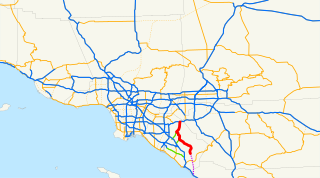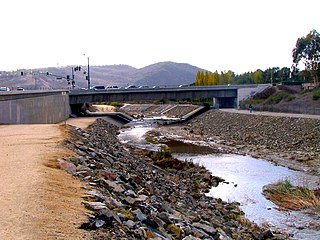
San Clemente is a coastal city in Orange County, California, United States. The population was 63,522 in at the 2010 census. Located on the California Coast, midway between Los Angeles and San Diego, the southernmost city of Orange County is known for its ocean, hill, and mountain views, a pleasant climate and its Spanish colonial-style architecture. San Clemente's city slogan is "Spanish Village by the Sea". The official city flower is the bougainvillea, and the official city tree is the coral. San Clemente is also the southernmost city in the Los Angeles metropolitan area.

Marine Corps Base Camp Pendleton is the major West Coast base of the United States Marine Corps and is one of the largest Marine Corps bases in the US. It is on the Southern California coast, in San Diego County, and bordered by Oceanside to the south, San Clemente, and Orange County to the north, Riverside County to the northeast, and Fallbrook to the east.

State Route 91 (SR 91) is a major east–west state highway in the U.S. state of California that serves several regions of the Greater Los Angeles urban area. A freeway throughout its entire length, it officially runs from Vermont Avenue in Gardena, just west of the junction with the Harbor Freeway, east to Riverside at the junction with the Pomona and Moreno Valley freeways.

State Route 133 is a state highway in the U.S. state of California, serving as an urban route in Orange County. It connects SR 1 in Laguna Beach through the San Joaquin Hills with several freeways in Irvine, ending at the SR 241, a toll road in the latter city. It is built as an expressway from SR 73 to Laguna Canyon Road, and past this, SR 133 is a freeway to I-5, and a tollway to SR 241 near the Santa Ana Mountains.

FasTrak is the electronic toll collection (ETC) system used in the state of California in the United States. The system is used statewide on all of the toll roads, toll bridges, and high-occupancy toll lanes along the California Freeway and Expressway System.

The El Toro "Y" is a freeway interchange in southern Orange County, California where the Santa Ana Freeway, Interstate 5 (I-5), and the San Diego Freeway merge. South of the El Toro Y, the highway is named the "San Diego Freeway" with the highway designation "I-5." Located in south Orange County where the cities of Lake Forest, Laguna Hills, and Irvine converge, the interchange was named after the nearby city and the now-closed Marine Corps Air Station El Toro, located northeast of the interchange.

State Route 73 is a state highway in the U.S. state of California, running from the junction with Interstate 5 in San Juan Capistrano north through the San Joaquin Hills to its junction with Interstate 405 in Costa Mesa. The entirety of the route is located in Orange County. From its southern terminus, the first 12 miles (19 km) of the highway are a toll road, which opened in November 1996. This segment of SR 73 is operated by the San Joaquin Hills Transportation Corridor Agency named the San Joaquin Hills Transportation Corridor. The last 3 miles (4.8 km) of the 15-mile (24 km) highway, which opened in 1978, are part of the Corona del Mar Freeway. SR 73's alignment follows an approximately parallel path between the Pacific Coast Highway and the San Diego Freeway. For the three-mile freeway segment, there are no HOV lanes currently, but the medians have been designed with sufficient clearance for their construction should the need arise in the future.

State Route 241 is a state highway in the U.S. state of California that is a toll road for its entire length within Orange County in the Greater Los Angeles urban area. Its southern half from near Las Flores to near Irvine is the Foothill Transportation Corridor, while its northern half to the State Route 91 at the Anaheim–Yorba Linda line is part of the Eastern Transportation Corridor. State Route 241 connects with the other two highways of the Eastern Transportation Corridor, State Route 133 and State Route 261.

San Onofre State Beach is a 3,000-acre (1,214 ha) state park in San Diego County, California. The beach is 3 miles (5 km) south of San Clemente on Interstate 5 at Basilone Road. The state park is leased to the state of California by the United States Marine Corps. Governor Ronald Reagan established San Onofre State Beach in 1971. With over 2.5 million visitors per year, it is one of the five most-visited state parks in California, hosting swimmers, campers, kayakers, birders, fishermen, bicyclists, sunbathers, surfers, and the sacred Native American site of Panhe.

Wildcoast is an international non-profit environmental organization that conserve coastal and marine ecosystem and wildlife.
Interstate 5 (I-5) is a major north–south route of the Interstate Highway System in the United States, stretching from the Mexican border at the San Ysidro crossing to the Canadian border near Blaine, Washington. From San Ysidro, the segment of I-5 in California runs north across the length of the state, and crosses into Oregon south of the Medford-Ashland metropolitan area. It is the more important and most-used of the two major north–south routes on the Pacific Coast, the other being U.S. Route 101 (US 101), which is primarily coastal. I-5 is known colloquially as "the 5" to Southern California residents and "5" to Northern California residents due to varieties in California English. The highway connects to the Mexican Federal Highway 1 (Fed. 1) in the south.
Mark Massara is an American surfer, attorney, and environmental conservationist. He first gained a reputation in the surfing and environmental communities when he won a $5.6 million Clean Water Act violation, the second largest ever collected. Since that case, he has assisted nonprofit organizations, including Surfrider Foundation and Sierra Club, government agencies, and private sector enterprises in several high-profile coastal and ocean protection, restoration, education and development campaigns that highlight and achieve coastal conservation and amenities for wildlife and future generations.

Aliso Creek is a 19.8-mile (31.9 km)-long, mostly urban stream in south Orange County, California. Originating in the Cleveland National Forest in the Santa Ana Mountains, it flows generally southwest and empties into the Pacific Ocean at Laguna Beach. The creek's watershed drains 34.9 square miles (90 km2), and it is joined by seven main tributaries. As of 2018, the watershed had a population of 144,000 divided among seven incorporated cities.

Laguna Canyon is a canyon that cuts through the San Joaquin Hills in southern Orange County, California, in the United States, directly south of the city of Irvine. The canyon runs from northeast to southwest, and is drained on the north side by tributaries of San Diego Creek and on the south by Laguna Canyon Creek. It is deeper and more rugged on the southwestern end near Laguna Beach.

Sulphur Creek is a 4.5-mile (7.2 km) tributary of Aliso Creek in Orange County in the U.S. state of California. The creek drains about 6 square miles (16 km2) of residential communities and parks in the southern San Joaquin Hills.

San Mateo Creek is a stream in Southern California in the United States, whose watershed mostly straddles the border of Orange and San Diego Counties. It is about 22 miles (35 km) long, flowing in a generally southwesterly direction. Draining a broad valley bounded by the Santa Ana Mountains and Santa Margarita Mountains, San Mateo Creek is notable for being one of the last unchannelized streams in Southern California.

Trestles Bridge, more formally known as Railroad Bridge 207.6 or the San Mateo Creek Bridge, is a low railroad viaduct on the coast of Southern California, in northern San Diego County near its border with Orange County. The bridge lies within San Onofre State Beach and gave its nickname to the famed Trestles surfing site at that beach.
Panhe, was one of the largest Acjachemen villages, that is over 8,000 years old and a current sacred, ceremonial, cultural, and burial site for the Acjachemen people. The site of Panhe, is now within San Onofre State Beach, San Diego County, California, located at the confluence of San Mateo Creek and Cristianitos Canyon, approximately 3.7 miles (6.0 km) upstream from the Pacific Ocean. The Acjachemen's fished in San Mateo Creek's extensive freshwater marshes, and practiced a hunter-gatherer lifestyle. The village of Panhe is estimated to have had a population of 300 or so before the first Spanish explorers came to the area, and is still a sacred site for the Native Americans.

"Surfin' U.S.A." is a song by the American rock band the Beach Boys credited to Chuck Berry and Brian Wilson. It is a rewritten version of Berry's "Sweet Little Sixteen" set to new lyrics penned by Wilson and an uncredited Mike Love. The song was released as a single on March 4, 1963, backed with "Shut Down". It was then placed as the opening track on their album of the same name.















